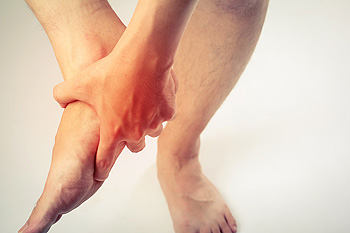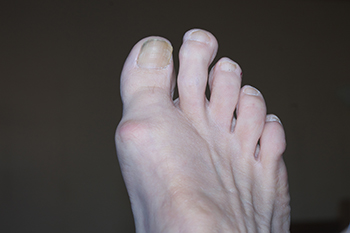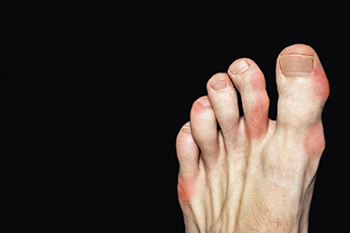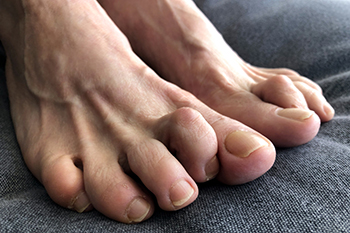Items filtered by date: November 2023
Treatment Options for Plantar Fasciitis

Plantar fasciitis, a common cause of heel and arch pain, arises from repeated micro-tears in the plantar fascia fibers, primarily at the point where the fascia connects to the heel bone. Stretching exercises are a vital treatment for plantar fasciitis. These exercises should focus on both the calf and the plantar fascia to yield maximum effectiveness, as tight calf muscles are a frequent cause of plantar fasciitis. Strengthening exercises that target intrinsic foot muscles and the calf muscles offer significant relief by stabilizing and supporting the foot and heel. Shoe inserts, such as gel heel pads or orthotics, are another simple, yet effective treatment. These aids vary from basic heel pads or cups that offer cushioning for the heel to custom-made orthotics prescribed by a podiatrist that correct abnormal foot positions, such as fallen arches. They reduce tension on the Achilles tendon and plantar fascia, providing much-needed comfort. Choosing the right footwear is an important way to manage plantar fasciitis. Opt for shoes that provide excellent cushioning and support, especially for the medial arch of the foot. Wearing shoes throughout the day, rather than walking barefoot, ensures continuous support and cushioning for the feet. If you are experiencing symptoms of plantar fasciitis, it is suggested that you make an appointment with a podiatrist who can safely guide your treatment and recovery.
Plantar fasciitis is a common foot condition that is often caused by a strain injury. If you are experiencing heel pain or symptoms of plantar fasciitis, contact Dr. Michael A. Wood from Foot Health Institute. Our doctor can provide the care you need to keep you pain-free and on your feet.
What Is Plantar Fasciitis?
Plantar fasciitis is one of the most common causes of heel pain. The plantar fascia is a ligament that connects your heel to the front of your foot. When this ligament becomes inflamed, plantar fasciitis is the result. If you have plantar fasciitis you will have a stabbing pain that usually occurs with your first steps in the morning. As the day progresses and you walk around more, this pain will start to disappear, but it will return after long periods of standing or sitting.
What Causes Plantar Fasciitis?
- Excessive running
- Having high arches in your feet
- Other foot issues such as flat feet
- Pregnancy (due to the sudden weight gain)
- Being on your feet very often
There are some risk factors that may make you more likely to develop plantar fasciitis compared to others. The condition most commonly affects adults between the ages of 40 and 60. It also tends to affect people who are obese because the extra pounds result in extra stress being placed on the plantar fascia.
Prevention
- Take good care of your feet – Wear shoes that have good arch support and heel cushioning.
- Maintain a healthy weight
- If you are a runner, alternate running with other sports that won’t cause heel pain
There are a variety of treatment options available for plantar fasciitis along with the pain that accompanies it. Additionally, physical therapy is a very important component in the treatment process. It is important that you meet with your podiatrist to determine which treatment option is best for you.
If you have any questions, please feel free to contact one of our offices located in Lansing, and Chicago, IL . We offer the newest diagnostic and treatment technologies for all your foot care needs.
Morton’s Toe Can Cause Pain

Morton's toe is characterized by the second toe appearing to be longer than the big toe. It is a prevalent foot structure that affects weight distribution and occasionally causes discomfort. Morton’s toe is a hereditary trait that has also been associated with potential advantages in athletics, as many professional athletes exhibit Morton's toe. Morton's toe is not actually caused by the second toe itself. In fact, its root lies in the metatarsals. When the first metatarsal is shorter, it makes the second toe seem longer. This condition leads to uneven weight distribution across the other bones of the feet. Over time, Morton’s toe may result in aches and pains, primarily felt at the base of the first two metatarsal bones and at the head of the second metatarsal. Fortunately, conservative treatments, such as padding, specific exercises, medication, and wearing custom orthotics can effectively manage the associated pain. For cases where conservative measures fall short, surgical options that call for removing certain toe joints are available. Seeking early intervention and consulting with a podiatrist can guide individuals with Morton's toe toward an appropriate and personalized course of action to maintain foot health and overall well being. For more information on Morton’s toe, it is suggested that you make an appointment with a podiatrist.
If you have any concerns about your feet, contact Dr. Michael A. Wood from Foot Health Institute. Our doctor can provide the care you need to keep you pain-free and on your feet.
Biomechanics in Podiatry
Podiatric biomechanics is a particular sector of specialty podiatry with licensed practitioners who are trained to diagnose and treat conditions affecting the foot, ankle and lower leg. Biomechanics deals with the forces that act against the body, causing an interference with the biological structures. It focuses on the movement of the ankle, the foot and the forces that interact with them.
A History of Biomechanics
- Biomechanics dates back to the BC era in Egypt where evidence of professional foot care has been recorded.
- In 1974, biomechanics gained a higher profile from the studies of Merton Root, who claimed that by changing or controlling the forces between the ankle and the foot, corrections or conditions could be implemented to gain strength and coordination in the area.
Modern technological improvements are based on past theories and therapeutic processes that provide a better understanding of podiatric concepts for biomechanics. Computers can provide accurate information about the forces and patterns of the feet and lower legs.
Understanding biomechanics of the feet can help improve and eliminate pain, stopping further stress to the foot.
If you have any questions please feel free to contact one of our offices located in Lansing, and Chicago, IL . We offer the newest diagnostic and treatment technologies for all your foot and ankle needs.
Definition and Risk Factors of Gout

Gout is a form of arthritis characterized by sudden, severe attacks of pain, swelling, redness, and tenderness in the joints. It typically affects the joint at the base of the big toe, but other joints can also be involved. Gout is caused by the buildup of uric acid crystals in the affected joint, which leads to inflammation and excruciating pain. While gout can affect anyone, it predominantly targets men, especially those over the age of 30. Women become more susceptible after menopause. Individuals with a family history of gout are at a higher risk, as genetics can play a significant role. Lifestyle factors such as a diet rich in purine-containing foods that include red meat, seafood, and alcohol, may significantly contribute to developing gout. Additionally, obesity and high blood pressure also increase the likelihood of getting gout. Understanding the definition and risk factors of gout is vital for timely diagnosis and effective management. If you have gout, it is strongly suggested that you are under the care of a podiatrist who can help you to manage this condition, in addition to offering you effective prevention strategies.
Gout is a foot condition that requires certain treatment and care. If you are seeking treatment, contact Dr. Michael A. Wood from Foot Health Institute. Our doctor will treat your foot and ankle needs.
What Is Gout?
Gout is a type of arthritis caused by a buildup of uric acid in the bloodstream. It often develops in the foot, especially the big toe area, although it can manifest in other parts of the body as well. Gout can make walking and standing very painful and is especially common in diabetics and the obese.
People typically get gout because of a poor diet. Genetic predisposition is also a factor. The children of parents who have had gout frequently have a chance of developing it themselves.
Gout can easily be identified by redness and inflammation of the big toe and the surrounding areas of the foot. Other symptoms include extreme fatigue, joint pain, and running high fevers. Sometimes corticosteroid drugs can be prescribed to treat gout, but the best way to combat this disease is to get more exercise and eat a better diet.
If you have any questions please feel free to contact one of our offices located in Lansing, and Chicago, IL . We offer the newest diagnostic and treatment technologies for all your foot and ankle needs.
Causes and Symptoms of Hammertoe

Hammertoe is a common foot condition that can cause discomfort and pain. It occurs when there is an imbalance in the muscles, tendons, or ligaments that normally hold the toe straight. One of the leading causes of hammertoe is wearing ill-fitting shoes, especially those with high heels or narrow, pointy toes, which force the toes into an unnatural position. Additionally, genetics can play a role, as some individuals may be more prone to developing hammertoe due to their family history. Arthritis and foot injuries are other contributing factors. The symptoms of hammertoe are quite noticeable. The affected toe tends to bend at the middle joint, resembling a hammer, hence the name. This deformity can lead to pain, corns, calluses, and discomfort while walking. Over time, hammertoe may become rigid, making it even more challenging to manage. Early detection and appropriate footwear choices are important for addressing this condition effectively. If you have the symptoms of hammertoe, it is suggested that you consult a podiatrist who can effectively diagnose and offer treatment options for this condition.
Hammertoe
Hammertoes can be a painful condition to live with. For more information, contact Dr. Michael A. Wood from Foot Health Institute. Our doctor will answer any of your foot- and ankle-related questions.
Hammertoe is a foot deformity that affects the joints of the second, third, fourth, or fifth toes of your feet. It is a painful foot condition in which these toes curl and arch up, which can often lead to pain when wearing footwear.
Symptoms
- Pain in the affected toes
- Development of corns or calluses due to friction
- Inflammation
- Redness
- Contracture of the toes
Causes
Genetics – People who are genetically predisposed to hammertoe are often more susceptible
Arthritis – Because arthritis affects the joints in your toes, further deformities stemming from arthritis can occur
Trauma – Direct trauma to the toes could potentially lead to hammertoe
Ill-fitting shoes – Undue pressure on the front of the toes from ill-fitting shoes can potentially lead to the development of hammertoe
Treatment
Orthotics – Custom made inserts can be used to help relieve pressure placed on the toes and therefore relieve some of the pain associated with it
Medications – Oral medications such as anti-inflammatories or NSAIDs could be used to treat the pain and inflammation hammertoes causes. Injections of corticosteroids are also sometimes used
Surgery – In more severe cases where the hammertoes have become more rigid, foot surgery is a potential option
If you have any questions please contact one of our offices located in Lansing, and Chicago, IL . We offer the newest diagnostic and treatment technologies for all your foot and ankle needs.

